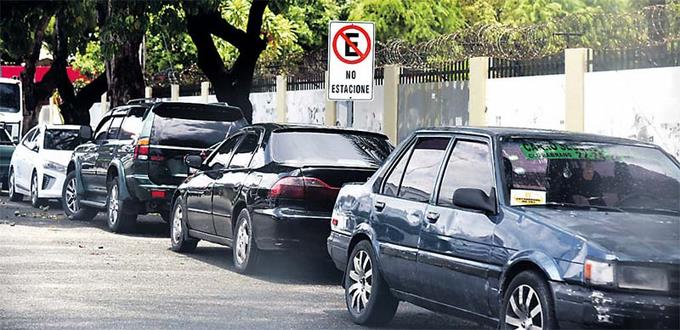Violations of the Traffic Law that are not being punished

Although the "No parking" sign is visible in the streets and avenues of the capital, its violation is common without being punished by the authority. JORGE MARTINEZ/LD
Temporary fines. The renewal of the tag must be carried out annually and not doing it in the established time entails fines for those who travel through the streets and payment of default when it is expired.
Passing by at a red traffic light, speeding, ignoring the stop sign, or not parking and going the wrong way, are some of the most common infractions on public roads in the country, according to the fine rate of government entities for inspection and traffic control.
However, these are not the only ones contemplated in Law 241-67, 214-01, 143-01, 63-17, and the regulations of the National Institute of Transit and Land Transportation (Intrant).
Turning around the corner of the lesser-known, but just as common, are, for example, the violation of articles 130, 157, and 158 of 241-67, which penalize throwing waste on public roads, not having a windshield, and the absence of a mirror, rear view mirror, respectively.
Those infractions are fined 1,000 pesos each, as well as those applied for driving a vehicle with excess passengers, transporting more than two people in the front seat, having tinted windows, and not stopping when a school vehicle is mounting or dismounting. users.
The law even contemplates the possession of emergency equipment ranging from red flags, tarpaulins, fire extinguishers, and even spotlights.
In article 164 of the traffic and vehicles law, promulgated on December 28, 1967, it is specified that buses and cargo transportation vehicles must be equipped with banners or, in substitution, with warning triangles.
Likewise, it orders that bus owners must be provided with at least one fire extinguisher, likewise, all motor vehicles with the exception of motorcycles, scooters, and similar must have a battery-powered light bulb.
Trucks and other cargo units are also prohibited from transporting people and if they do so they would be fined 1,000 pesos.
Plates
On the other hand, the non-possession of plates or plates in questionable conditions could imply an expense in fines of up to 10,000 pesos. In the Digesett rate, the maximum amount for not having it, additions, or expiration of the plate is 1,000 pesos, however, in the Intrant, the same infractions suppose an imposition of 10,000.
The cost of fines at the National Institute of Traffic and Land Transportation rose to that figure after the 2019 update that raised the fee by 4,883 pesos more.
Added to these traffic crimes are others that are well known but whose recurrence and sanction are conditioned by specific periods.
The Label
The renewal of the label that must be carried out annually and that, despite being a constant, generates traumas in the population, and not doing it on time leads to delays and fines.
The tag is an adhesive label, with a numerical sequence, used as control and evidence of tax payment and vehicle technical inspection certification.
When the deadlines to renew are met, infractions for not carrying it usually come to light.
Other traffic violations indicated as common in the digital portal of the Digesett are driving on streets lit with high beams or on the contrary with them off, not having a red light on the back, not having turn signals, traveling in a vehicle with guides on the right side, produce unnecessary noise and lack of silencer in the exhaust pipe. In addition, transporting cargo that protrudes more than authorized in the front; driving without a license or expired; as well as traveling with a driving license of a lower category.
The infraction of carrying false information is added; backing up obstructing traffic; failing to yield to emergency vehicles; making a prohibited turn or U-turn, obstructing the pedestrian crossing, taking or dismounting passengers in prohibited areas, parking at bus stops, obstructing traffic, violating traffic signals and parking in prohibited places.
Prohibited zones
Regarding the areas where it is not allowed to park vehicles, sidewalks, street or highway crossings, over pedestrian crossings or in places designed exclusively for them, parallel to or on the opposite side of an obstruction or excavation, on bridges, tunnels, stand out. , overpasses, slopes, and curves.
Nor should you park less than 10 meters from a traffic signal (stop, give way, curve, or traffic light), five meters from a hydrant or water pump, or a corner; a distance of fewer than 20 meters from a public passenger transport stop or at the origin opposite to the traffic of the road.
From 1,000 to 10,000 pesos must be paid for breaking traffic laws in the country.


















More dangerous are the several buggy/atv companies offering tours, driving on public roads, back roads are public also!!, with vehicles that are homemade. Plastic seatbelts, gas tanks(homemade) mounted on top of an exhaust pipe, or alternator or next to batteries, no adjustable seats for the drivers, no rearview mirrors, no stop lights, number plates no handbrake. While intrant doesn’t know what they are doing, because civil engineers are in charge and not car engineers, because that doesn’t exist in the country
The ATV and buggy tours are given license by the Ministry of Tourism to operate certain routes. Intrant regulations are overlooked, because tourism has control.
If the government enforced just a few of these laws by handing out fines, they could make a fortune!